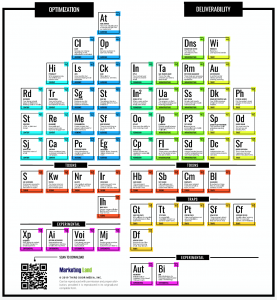For B2B marketers, developing a compelling and rock-solid value proposition can be time-consuming and challenging, sometimes even fraught with internal politics and entrenched attitudes that are difficult to overcome for even the most experienced. The more complex the product or solution, and more diverse the target audience, the harder the challenges become.
In many organizations, marketing either has virtually no voice at all in the value proposition creation process or is solely responsible for it. Neither is ideal. In the former, when marketing is brought in when the product or service is almost fully conceptualized and ready to launch, the value proposition created can be far too generic or can miss the mark altogether. In the latter, when marketing creates the value proposition and hands it off to the rest of the organization, the same outcome can result.
The reality is that the value proposition for your product or service is everyone’s responsibility. Each actor in the product or service development process, from business units, to IT, to customer service, to sales, must be thinking about and shaping the value proposition from day one. In fact, if that process isn’t happening in your organization, and you’re ready to launch, you should probably press pause, rewind, and back up to a point where you can get everyone aligned.
In the best-case scenario, marketing will lead the process or be intimately involved as a key stakeholder providing insight each step of the way. While they likely won’t know every technical detail – feeds, speeds and specifications – they can serve a critical role: to shape, validate and shepherd the process to a successful outcome.
So if we start with the premise that marketing is responsible for shepherding the value proposition creation process, not creating it from whole cloth, what role should marketing play?
Value Propositions in a Post-Funnel World
In their February 24 article for The Economist, The Funnel is Dead, Long Live the Customer Decision Journey, McKinsey & Company’s David Edelman and Francesco Banfi explain how digital has transformed the customer buying process. Where the traditional funnel used to rule is now an ongoing process of exploration, experimentation, purchase, validation and (if the stars align) advocacy. Their focus is B2C, but many of the same rules apply in B2B. B2B buyers bring the same expectations to their business and consumer purchase experiences.
In this new environment, marketing can play two important roles:
1) To provide customer and competitor insight at the front-end throughout the product or service development process; and,
2) To provide superior operational excellence at the back-end to ensure the value proposition is delivered consistently and effectively across the entire B2B customer journey.
Value propositions typically fall into one of the following 10 categories:
- Performance — Does your product or service deliver a higher level of performance than its competitors? Be careful if you use this one since you’ll have to be able to justify this value prop with quantifiable, validated metrics. If you try to fake it until you make it, and your message will fall flat.
- Customization — Does your product or service allow your buyers to experience a level of personalization that exceeds that of your competition?
- Getting the Job Done — This sounds simple too, but for industries like software development, manufacturing and IT security, a verifiable track record of getting the job done can be incredibly compelling.
- Design – Do you have a superior aesthetic from a technical or visual perspective? This point of differentiation is one of the most enjoyable to market because there are so many ways to bring it to life.
- Brand/Status — One of the most difficult points of differentiation because it is both expensive to market and almost equally as ephemeral depending on your product or service.
- Price — While many marketers vehemently resist using price as a point of differentiation, price can be a very effective point of persuasion. If the angle is low price, it can be difficult to sustain over time. High price points can help differentiate and be an effective element of a value proposition, but that high price makes a promise to your buyer. If not delivered on, your buyer can quickly become dissatisfied.
- Cost Reduction — We need only look at what Amazon Web Services has achieved in the hosting market over the last eight to ten years to understand the power of cost reduction as a value proposition. This value prop needs to be supported by a rock solid service delivery record in order to be sustainable over time.
- Risk Reduction – Think about the last time you saw an Aflac commercial. This is a business built entirely on their customers’ perception of their personal health and wellness. I carried Aflac policies for many years without ever filing a claim. Eventually I started looking at the cost-benefit and figured I’d make out better shouldering the risk on my own.
- Accessibility — Here’s a great value proposition that will really attract and retain your customers if it’s marketed correctly. You need only look to Salesforce.com for an incredibly compelling proof point: “Salesforce (NYSE:CRM) is the worldwide leader in CRM software, with 16.1% market share. Salesforce grew 30.3% from 2012, when the company attained revenues of $ 2.52B, outdistancing SAP SAP’s12.7% growth, Microsoft Microsoft’s 22.8% and IBM IBM’s 22% yearly growth.”
- Convenience/Usability — It can be tricky to build a value proposition on convenience and usability alone. For the past few years, we’ve used a point solution for marketing automation. It’s inexpensive, relatively easy to use and works OK. The only problem is when there’s a problem. Customer support for system issues is very limited and non-responsive. Open tickets take days and sometimes weeks to close. The lesson here is that highly accessible, poor service is still poor service after all.
First, Decide What You’re Not Going to Do or Be
If you’re creating a value proposition for a new product service (or even if you’re repositioning your product to serve new target audiences or industries), once you’ve defined the business goals, the most logical place to start is by deciding what the product will NOT be or do. It’s a bit counter-intuitive and typically the hardest part of the exercise. Here’s why: by deciding what your product will not do or be, you will also be cutting off potential avenues and opportunities for revenue, most likely in the near-term. Now more than ever, the pressure to deliver near-term results can be overwhelming and can convince even the most enlightened marketers to make short-term revenue decisions that can ultimately jeopardize long-term success.
By focusing on a differentiated message in one of these categories you will have taken the first step to clarity. With clarity around your value prop you can achieve consistency. With consistency comes trust and believability in the hearts and minds of your customers. All these elements put together create a compelling value proposition.
Bringing it Home – A Hypothetical Case Study of Value Proposition Creation
The following is a super simple case study of value proposition creation:
Product A allows marketers to manage their entire catalog of marketing content through a mobile app and website. Our target buyer is a marketing leader aged 35-45 who values time as their most precious commodity. This individual is under constant pressure to create new marketing assets that can be customized to meet sales leadership’s needs. That means that they believe their existing marketing assets should be managed proactively and that their first inclination when asked to create something new is to look at what they already have.
Product A helps marketers know which marketing assets they have, how long they have had them and which assets are used most often versus the ones that get created and put on the shelf. What’s more, they can use Product A to assemble a marketing slick on the fly, whether they’re at their desk, at a coffee shop or on the beach.
Customers love the product because it assures them that they are not only saving time and being responsible with their marketing assets, but also because it allows them to create unique, customized marketing collateral for every need without investing an inordinate amount of staff time.
Based on the hypothetical description provided above, we could likely choose any of the ten categories of value proposition creation. We could make a case for cost reduction as the product maximizes efficiency and re-use of assets. We could argue for customization as the core value proposition because the product makes it so easy to deliver personalized sales presentations for the sales team. We could even go so far as to argue risk reduction as the core value proposition given the level of control Product A provides marketers when creating and managing marketing assets.
Because time is more valuable than money for buyers of Product A, then in this case we’ll select convenience and usability as the core value proposition for the product. Every element of the branding and marketing plan will indicate the value of immediacy, action and responsiveness. Based on this decision, we’ve decided to name the Product Swift. Every element of the marketing plan should therefore reinforce this value proposition. From logo selection, to website design and usability, to the selection of media and advertising, will reinforce the Swift brand promise.
3 Steps to Get Sales On Board
Time and again, particularly in B2B organizations, we see a significant gap between sales and the rest of the organization. Sales leaders tend to find marketing-driven value propositions too generic. Sales has their own view of the value proposition that is going to resonate with their customers and that view may be tangential or completely different than marketing’s view. While the risk is that this ongoing conflict between sales and marketing will breed confusion, it’s a healthy conflict that should be encouraged. Assuming that this conflict exists in your organization, your real challenge becomes how to involve sales leadership in the value proposition creation process in a consistent way from start to finish.
The best sales professionals are smart, impatient and only care about the facts. They need to be led to the solution, not fed. What does leading look like?
- Do your homework and gather the data. Be ready to share insights on the competitive landscape such as pricing, positioning, key players and influencers. Make sure you have this information in a format that is easy for the sales team to access and refer to. Weave in third-party validation and any primary or secondary research you can gather about your buyers’ needs.
- Be patient and invest as much time as necessary. Face time is very helpful, if that’s physically possible for you. Appeal to your sales team’s extroverted nature and give them an opportunity to say what they think. If it’s not possible to meet with your sales leaders face-to-face, use tools like video streaming and interactive white boards. If you’re engaging your sales team in a large meeting format, never underestimate the importance of the pre- and post-meeting side conversations to socialize your ideas.
- Keep it short and concise. Make sure the data is available in just a few clicks – no more than three is a good rule of thumb! Invest time in design and copywriting talent to ensure that your message is both visually appealing with concise messaging.
The goal of course is to give your sales leaders sufficient information and time to understand, internalize and transform the content into their own language. With these inputs, you’ll achieve consistency and alignment when you’re ready to execute.
Business Articles | Business 2 Community
(336)
Report Post




